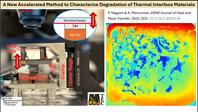A New Accelerated Method to Characterize Degradation of Thermal Interface Materials
A New Accelerated Method to Characterize Degradation of Thermal Interface Materials
| Event Date: | October 2, 2025 |
|---|---|
| Authors: | P. Nagrani and A. Marconnet |
| Journal: | ASME Journal of Heat & Mass Transfer |
| Paper URL: | Link to Full Text |
Due to advances in the 3D integration and miniaturization of chips, the power density and number of hotspots within electronic packages have increased rapidly. One of the major bottlenecks in the chip-to-coolant thermal resistance pathway is the interfacial resistance at solid-solid contacts. For example, thermal interface materials (TIMs) are employed between the chip and the lid or between the lid and the heat sink to minimize interfacial thermal resistances. However, thermal greases (a common paste-like TIM) often degrade over time via pumpout (the material moves out of the interface) and dryout (phase separation of the composite material) phenomena due to repeated heating and cooling of the die. Traditionally, the reliability of thermal grease is assessed through thermal cycling tests, but these techniques have long testing periods (e.g., days, months, or longer). In this study, to accelerate the observation of the degradation of thermal greases, we propose adding mechanical cycling while maintaining a constant heat flow rate through the sample. We investigate the reliability of three thermal greases at different oscillation amplitudes and squeezing pressures using a state-of-the-art in-house designed and machined experimental rig. We leverage high-resolution infrared imaging of thermal grease under mechanical oscillations to capture steady-state 2D temperature maps, from which we calculate mechanical and thermal reliability metrics such as void fraction and comparison of area-normalized thermal resistance at the beginning- and end-of-life. In parallel, we characterize the thermal conductivity and rheological properties of the same materials. Our results uncover that the mechanical reliability of thermal greases depends on the ratio of elastic modulus to viscosity, with higher ratios being more desirable. While, the thermal reliability depends upon the synergy of material properties with higher elastic modulus and higher thermal conductivity resulting in a lesser increase in thermal resistance over the lifetime of thermal greases.

